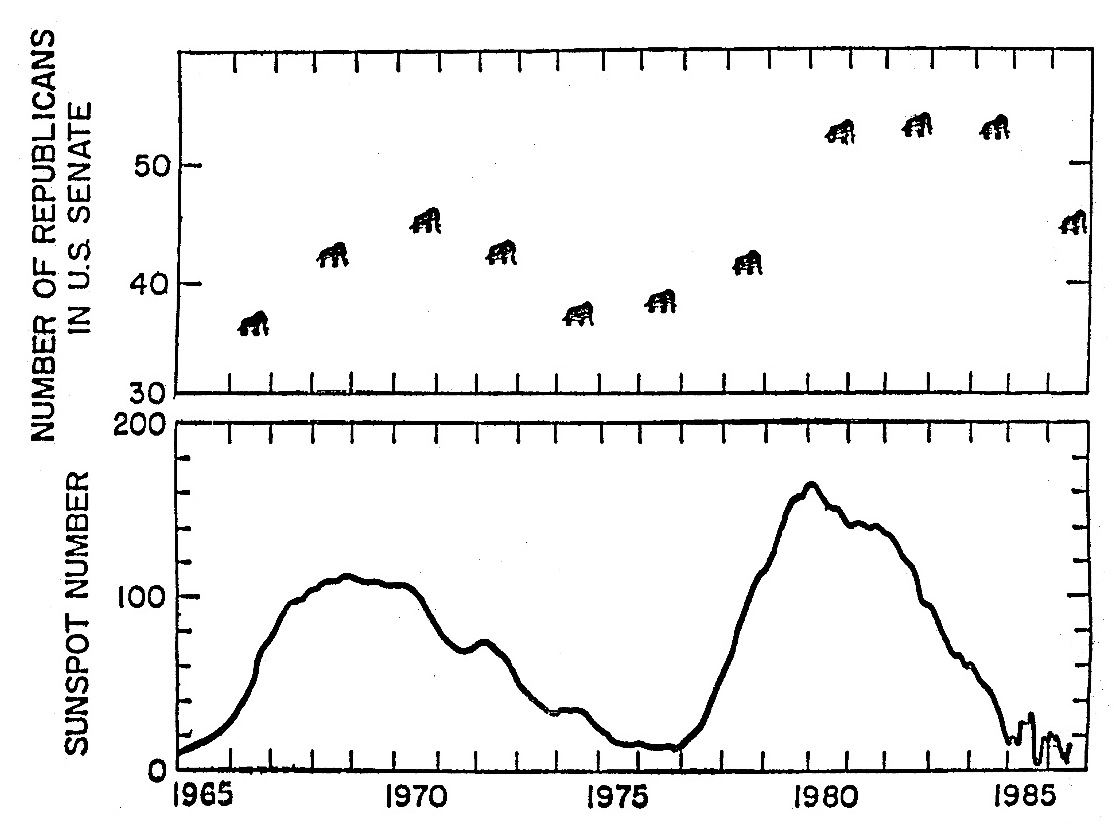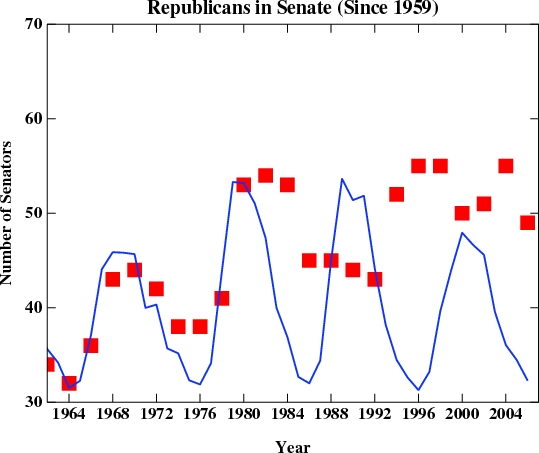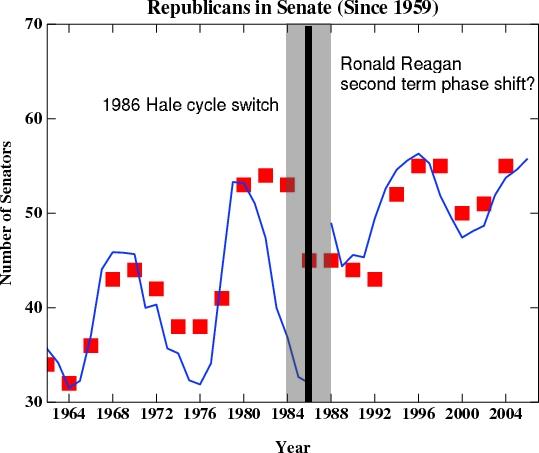Ingilizce’den çeviren Figen Mekik
Güneşle ilgili çeşitli indislerle iklim değişikliği arasinda görülen ve görünürde inanilmaz olan korelasyonlarla sık sık saldırıya uğruyoruz. Hatta bu korelasyonların nasıl gizemli ve el altından yollarla daha da harika hale getirildiği, “Büyük Küresel Isınma Aldatması” adlı filimle dalga geçen bir yayında geçen ay ele alındı. Ama bu islah yöntemleri (mesela, eksenleri değiş tokuş etmek, var olmayan veri noktalarını grafiklere eklemek, istenilen eğilime uymayan veri noktalarını çıkarmak gibi) kullanılmadan dahi “yayınlanan bilgiler” yüzeysel olarak etkileyici hani. Peki biz neden etkilenmedik o zaman?
Size bu konuda fikir vermek amacıyla, güneş/iklim bilimcilerinden küçük bir azınlığın öncülüğünü yaptığı metodları kullanarak (ve gerekli yerlerde atıflar da olacak tabii) yeni bir siyasi yaklaşımın üretilmesini amaçlayan bir egzersiz yapacağım.. Ve konumuza daha da uygun olsun diye, Richard Lindzen’in ofis kapısını pek çok yıl süsleyen bir grafik ile başlayacağım:

Evet, doğru okudunuz. Ekonomi veya savaşları unutun, Cumhuriyetçi partinin kaderini güneş lekelerindeki evreler belirliyor.

Evet, bu doğru tabii. Ama grafiğin sol kısmındaki iyi korelasyon hala kayda değer (r = 0.52! 1960-1986); dolayısıyla, sonra nasıl bozulduğunu göz ardı ederek buna sık sık atıf yapabiliriz (mesela Svenmark, 2007’de Marsh and Svenmark 2000’den bahsettikleri gibi). Ama daha önemlisi, bu sadece kuramımızın biraz ayarlanmaya gerek duyduğunu gösteriyor.
Grafiğimizin ikinci yarısına bakalım. Eh bu dönem içinde güçlü bir korelasyon var aslında (r = 0.63, 1988-2006). Ancak bu sefer korelasyonumuz ters. Ama bu kimseyi şaşırtmamalı. Güneş – senatör ilişkileri karışık malum.


Bazı okuyucularımız diyebilirler ki herhangi bir mekanizma öne sürülmeden gösterilen bu güçlü korelasyonlar bir matematik oyunundan başka bir şey değil; ve hatta diyebilirler ki yanlış ve güdümlü bir mantıkla elde edilen veri eğilimlerinin hiç bir değeri yok. Bu mantıklı bir iddia gibi görünebilir. Ancak tabii ki deneyler yapmadan nihai sonuçlara ulaşmak mümkün değil. Bu çok ilginç sonuçlarımızı temel alarak, Cumhuriyetçi senatörleri çeşitli kuvvette kozmik ışınımlara maruz bıraktıktan sonra seçilebilirliklerini ölçmeyi öne sürüyoruz. Bunu yapmamıza engel olmak isteyecek fon veren kuruluşların veya etik kurullarının tutumu, sadece siyasi “fikir birlik”lerini bozulacağından korktuklarını gösterir.
Inandırıcı, değil mi?
Güneş lekeleri ve senatörlerle ilgili veriler muhakkak ki benim yaptığımdan daha güzel kurcalanabilir. Ben, çeşitli gecikme, filtre (Friis-Christensen and Lassen, 1991), bazı eğilimleri giderme (mesela Marsh and Svensmark, 2003) veya birbiriyle alakasız veri tabanlarını ayırma (mesela Svensmark ve Friis-Christensen 1997, Nir Shaviv) metodlarından hiç birini kullanmadım. “Leyleğin neler getirdiğine dair yeni veriler” (Hofer ve diğerleri, 2004) adlı eserden başka fikirler de edinebilirsiniz. Benden daha başarılı veri kurcalama yöntemleri gösterebilecek okurlarımıza özel tebriklerimiz olacak.
Hmmm, … OK … explicit link in #349 above that this forum mysteriously screws up – looks like a deficiency in the even more mysterious “securebar.secure-tunnel” wotsit thing:
Screwed up link:
https://www.realclimate.org/index.php/archives/2007/02/save-the-world-earn-25-million/#comment-28597
In context appearance of link:
” …
P.S: Are the “resident” gurus who contribute here, just naturally rude, or just really really busy? I asked what I thought were some reasonable questions ages ago in another RealClimate forum, and after just one other not very helpful and really not too sensible reply that seemed to completely ignore enthalpies of formation, etc. that forum was shut down for further posts – and thereby any answers to the questions posed there that I could easily find. Any chance anyone here can address the questions there?
I’m busy too, so can’t be bothered re-formatting the post, so here’s the [explicit] link to it:
https://www.realclimate.org/index.php/archives/2007/02/save-the-world-earn-25-million/#comment-28597 “
Mr. Revell asked in the other thread a lot of questions. You can find most answers to FAQs with the search box, top of the page.
> who has entered, R. Branson’s Virgin Earth Challenge
Try his website or Google
> Anybody know where I can get a [reference mentioned] – I mean without having to pay?
Ask your local public library Reference Desk; if not available, they will be able to borrow a copy via interlibrary loan.
>How do you get an article/paper published here?
None are. See Contributors’ links on right side for their publications.
Most of us posting here are just interested readers.
So, my comments do not ‘pass the test’. In any case I suggest you read Three Men in a Boat by Jerome K Jerome. That’ll cheer you up. The future’s not so bad.
PHE (#353) wrote:
The future?
I am still hoping that it hasn’t been written yet – or at least not the last few chapters of it. But if I need some cheering up or just wish to enjoy myself for a short time, Babylon 5 generally does the trick for me. At this point I think I will spend some time with G’Kar, Londo and Vir. Or maybe I will watch the first movie.
Hank, the time scale for the first two is on their axis (doesn’t read well-agreed), and is between 1000 to ~2000 AD. This link is working
http://pg.photos.yahoo.com/ph/dimispoulos/detail?.dir=7156re2&.dnm=6de4scd.jpg
Re. #38:
You give the impression here that there are several competing “standard models” that all propose to explain the single phenomenon of supernovae, but that isn’t how supernova science works. There are many different types of supernovae, and some have very different physical causes than others. SN2006gy is evidence not for an “alternative model,” but for a new type of supernova that has been proposed before, but never observed (until, perhaps, now).
Just wanted to set the record straight!